

Handgun Recoil Table. By Chuck Hawks For every action there is an equal and opposite reaction; that is one of the physical laws of our universe.
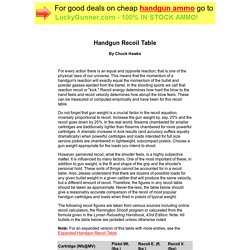
This means that the momentum of a handgun's reaction will exactly equal the momentum of the bullet and powder gasses ejected from the barrel. In the shooting sports we call that reaction recoil or "kick. " Recoil energy determines how hard the blow to the hand feels and recoil velocity determines how abrupt the blow feels. These can be measured or computed empirically and have been for this recoil table. Do not forget that gun weight is a crucial factor in the recoil equation, inversely proportional to recoil.
2aShootingCenter. GOOD FIRST BIG GAME RIFLES. By Chuck Hawks This piece is directed primarily to the person thinking about getting their first big game rifle.
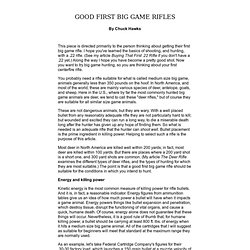
I hope you've learned the basics of shooting, and hunting, with a .22 rifle. (See my article Buying That First .22 Rifle if you don't have a .22 yet.) Along the way I hope you have become a pretty good shot. Now you want to try big game hunting, so you are thinking about your first centerfire rifle. You probably need a rifle suitable for what is called medium size big game, animals generally less than 350 pounds on the hoof. These are not dangerous animals, but they are wary. Most deer in North America are killed well within 200 yards; in fact, most deer are killed within 100 yards. Energy and killing power Kinetic energy is the most common measure of killing power for rifle bullets.
As an example, let's take Federal Cartridge Company's figures for their .30-30 factory load, which launches a 150 grain bullet at a muzzle velocity of 2,390 fps. Trajectory Recoil or "kick" Ideal General Purpose Deer and Antelope Rifles. By Chuck Hawks Choosing a perfect general purpose hunting rifle for all CXP2 class game under all normal conditions can be a daunting task, particularly for less experienced shooters.
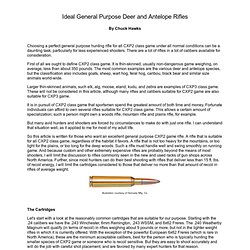
There are a lot of rifles in a lot of calibers available for consideration. First of all we ought to define CXP2 class game. It is thin-skinned, usually non-dangerous game weighing, on average, less than about 350 pounds. The most common examples are the various deer and antelope species, but the classification also includes goats, sheep, wart hog, feral hog, caribou, black bear and similar size animals world-wide. Larger thin-skinned animals, such elk, alg, moose, eland, kudu, and zebra are examples of CXP3 class game. It is in pursuit of CXP2 class game that sportsmen spend the greatest amount of both time and money.
But many avid hunters and shooters are forced by circumstances to make do with just one rifle. Building a Hunting Rifle Battery. By Chuck Hawks I have already written articles covering "Good First Rifles," "The One Rifle Big Game Hunter," and "Matching the Gun to the Game" so this one is going to be about building a coherent rifle battery.
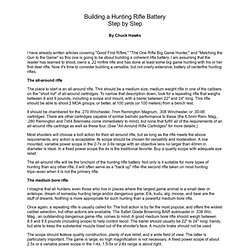
I am assuming that the reader has learned to shoot, owns a .22 rimfire rifle and has done at least some big game hunting with his or her first deer rifle. Now it's time to consider building a versatile, but not overly extensive, battery of centerfire hunting rifles. Choosing a Hunting Rifle. In order to safely fire a cartridge, the rifle must be designed to fire that specific cartridge.
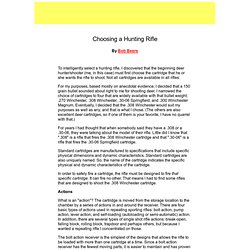
It can fire no other. That means I had to find some rifles that are designed to shoot the .308 Winchester cartridge. Actions What is an "action"? The cartridge is moved from the storage location to the chamber by a series of actions in and around the receiver. The bolt action receiver is the simplest of the designs that allows the rifle to be loaded with more than one cartridge at a time. Stock Materials Stock materials are generally wood, laminated wood, and plastic/fiberglass. Wood is the traditional stock material, and walnut is the wood of choice because of its inherent characteristics, although cheaper hardwoods are also widely used. Laminated woods are the strongest and most durable of all common stock materials. Synthetic materials are gaining popularity, not only because they are typically less expensive, but less affected by moisture than walnut stocks. Barrel length. Rifle Recoil Table. By Chuck Hawks For every action there is an equal and opposite reaction; that is one of the physical laws of our universe.
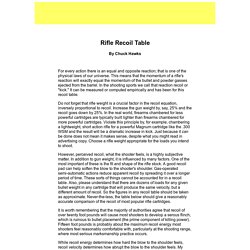
This means that the momentum of a rifle's reaction will exactly equal the momentum of the bullet and powder gasses ejected from the barrel. In the shooting sports we call that reaction recoil or "kick. " It can be measured or computed empirically and has been for this recoil table. Rifle Ballistics Table - Improved. By Chuck Hawks For an expanded version of this table showing more loads, including British, European, wildcat, proprietary and obsolescent American calibers, see the "Expanded and Improved Rifle Ballistics Table" on the Tables, Charts and Lists Page.
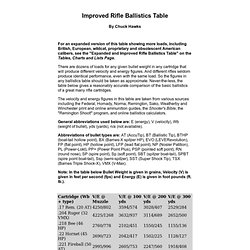
There are dozens of loads for any given bullet weight in any cartridge that will produce different velocity and energy figures. And different rifles seldom produce identical performance, even with the same load. So the figures in any ballistics table should be taken as approximate. - Traditional Muzzleloading Forum - Muzzleloader Flintlock Black Powder. American Rifleman - An Official Journal of the NRA. Getting Started In Cowboy Action Shooting, Page 2, Revolvers.